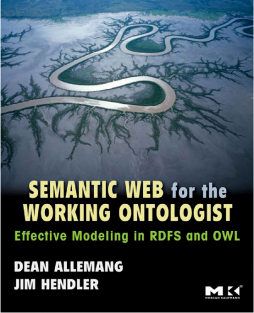
Additional Information
Book Details
Abstract
The promise of the Semantic Web to provide a universal medium to exchange data information and knowledge has been well publicized. There are many sources too for basic information on the extensions to the WWW that permit content to be expressed in natural language yet used by software agents to easily find, share and integrate information. Until now individuals engaged in creating ontologies-- formal descriptions of the concepts, terms, and relationships within a given knowledge domain-- have had no sources beyond the technical standards documents.
Semantic Web for the Working Ontologist transforms this information into the practical knowledge that programmers and subject domain experts need. Authors Allemang and Hendler begin with solutions to the basic problems, but don’t stop there: they demonstrate how to develop your own solutions to problems of increasing complexity and ensure that your skills will keep pace with the continued evolution of the Semantic Web.
• Provides practical information for all programmers and subject matter experts engaged in modeling data to fit the requirements of the Semantic Web.
• De-emphasizes algorithms and proofs, focusing instead on real-world problems, creative solutions, and highly illustrative examples.
• Presents detailed, ready-to-apply “recipes for use in many specific situations.
• Shows how to create new recipes from RDF, RDFS, and OWL constructs.
“The Missing Link: Hendler and Allemang’s new book is exactly what our industry is looking for. We have many introductory books, and some compilations of papers but very little to help a practitioner move up their experience curve from novice to journeyman ontologist. The book is very readable; the examples are plentiful and easily understandable. I’ve already been recommending students and clients pre-order this book - David McComb, President, Semantic Arts, Inc. www.semanticarts.com
“This is by far the best introduction to the semantic web currently available, from a practitioner’s point of view. There are meaty examples that move beyond the theory and hype. You will get a clear understanding of what RDF, RDF Schema and OWL are all about – both in terms of what they are and how to use them. You will learn a variety of hard-nosed and hard-won practical guidelines gained from years of experience building and deploying ontologies “in the trenches? Semantic Web for the Working Ontologist fills a much needed gap in the literature. It represents an impressive collection and synthesis of a wide variety of sources that have hitherto been scattered among academic books and papers, W3C working group notes, talks, blogs and email discussion groups. I expect to refer to this book often. - Dr. Michael Uschold, Internationally recognized expert in ontologies and semantic web technologies both in academia and industry.
“At the time when the world needs to find consensus on a wide range of subjects, publication of this book carries special importance. Crossing over East-West cultural differences, I hope semantic web technology contributes to bridge different ontologies and helps build the foundation for consensus towards the global community. - Toru Ishida, Department of Social Informatics, Kyoto University Yoshida-Honmachi
“Despite all the excitement about the Semantic Web, the principles of actually using Semantic Web standards to create useful applications have been buried in tedious documents and e-mail threads. This volume—written by two leaders in the Semantic Web community who represent perfectly the academic and the industrial perspective—makes the arcane knowledge needed to build intelligent Web applications accessible and understandable. This is a great introduction to the Semantic Web and its associated knowledge-representation standards. More important, the book shows how to use the standards, and does so in a lively and lucid way. - Mark A. Musen, Professor of Medicine and Computer Science, Stanford University; Director, the National Center for Biomedical Ontology; Director, the Protégé Project
"Semantics are no longer contained to the realm of theorists but are now being applied to help large leaning-forward organizations wrestle with information discovery and reuse. Here is a practical guide written for those who are seeking insight on techniques for real-world applications." – Andrew Schain, Visiting researcher, Maryland Information and Network Dynamtics Laboratory
